人教版 初一英语语法大全
新人教版七年级英语语法知识总结
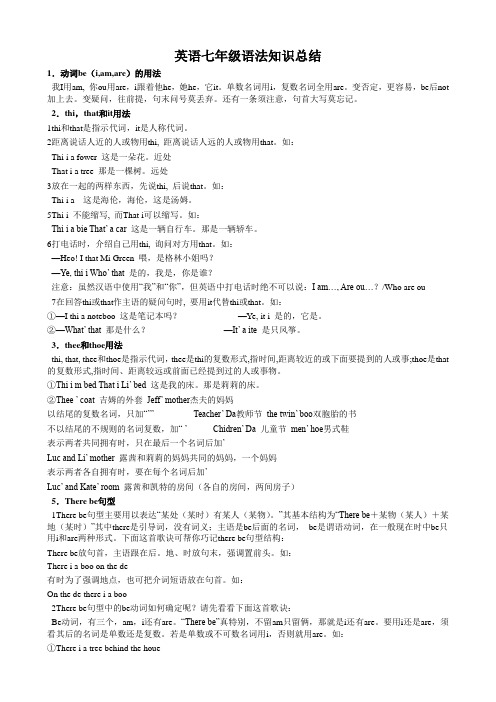
英语七年级语法知识总结1.动词be(i,am,are)的用法我I用am, 你ou用are,i跟着他he,她he,它it。
单数名词用i,复数名词全用are。
变否定,更容易,be后not 加上去。
变疑问,往前提,句末问号莫丢弃。
还有一条须注意,句首大写莫忘记。
2.thi,that和it用法1thi和that是指示代词,it是人称代词。
2距离说话人近的人或物用thi, 距离说话人远的人或物用that。
如:Thi i a fower 这是一朵花。
近处That i a tree 那是一棵树。
远处3放在一起的两样东西,先说thi, 后说that。
如:Thi i a 这是海伦,海伦,这是汤姆。
5Thi i 不能缩写, 而That i可以缩写。
如:Thi i a bie That’ a car 这是一辆自行车。
那是一辆轿车。
6打电话时,介绍自己用thi, 询问对方用that。
如:—Heo! I that Mi Green 喂,是格林小姐吗?—Ye, thi i Who’ that 是的,我是,你是谁?注意:虽然汉语中使用“我”和“你”,但英语中打电话时绝不可以说:I am…,Are ou…?/Who are ou7在回答thi或that作主语的疑问句时, 要用it代替thi或that。
如:①—I thi a noteboo 这是笔记本吗?—Ye, it i 是的,它是。
②—What’ that 那是什么?—It’ a ite 是只风筝。
3.thee和thoe用法thi, that, thee和thoe是指示代词,thee是thi的复数形式,指时间,距离较近的或下面要提到的人或事;thoe是that 的复数形式,指时间、距离较远或前面已经提到过的人或事物。
①Thi i m bed That i Li’ bed 这是我的床。
那是莉莉的床。
②Thee ’ coat 吉姆的外套Jeff’ mother杰夫的妈妈以结尾的复数名词,只加“’”Teacher’ Da教师节the twin’ boo双胞胎的书不以结尾的不规则的名词复数,加“ ’ Chidren’ Da 儿童节men’ hoe男式鞋表示两者共同拥有时,只在最后一个名词后加’Luc and Li’ mother 露茜和莉莉的妈妈共同的妈妈,一个妈妈表示两者各自拥有时,要在每个名词后加’Luc’ and Kate’ room 露茜和凯特的房间(各自的房间,两间房子)5.There be句型1There be句型主要用以表达“某处(某时)有某人(某物)。
(完整版)初一英语语法大全知识点
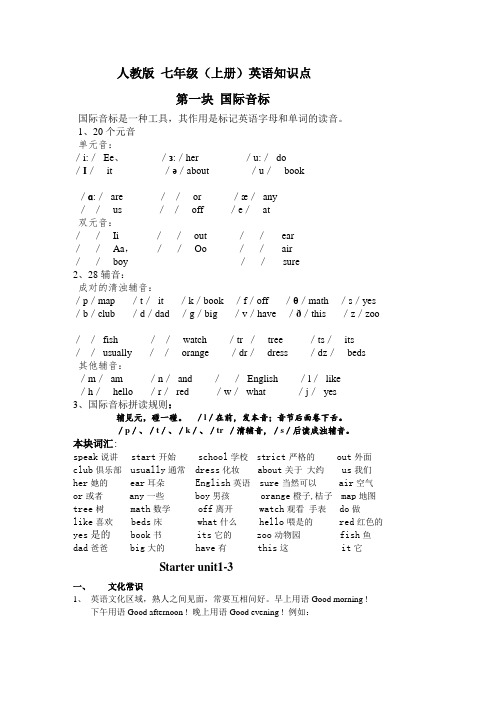
人教版七年级(上册)英语知识点第一块国际音标国际音标是一种工具,其作用是标记英语字母和单词的读音。
1、20个元音单元音:/i:/Ee、/з:/her /u:/do/I/it /ә/about /u/book/ɑ:/are //or /æ/any//us //off /e/at双元音://Ii //out //ear//Aa,//Oo //air//boy //sure2、28辅音:成对的清浊辅音:/p/map /t/it /k/book /f/off /θ/math /s/yes /b/club /d/dad /g/big /v/have /ð/this /z/zoo//fish //watch /tr/tree /ts/its//usually //orange /dr/dress /dz/beds其他辅音:/m/am /n/and //English /l/like/h/hello /r/red /w/what /j/yes3、国际音标拼读规则:辅见元,碰一碰。
/l/在前,发本音;音节后面卷下舌。
/p/、/t/、/k/、/tr /清辅音,/s/后读成浊辅音。
本块词汇:speak说讲start开始school学校 s trict严格的out外面club俱乐部usually通常 dress化妆about关于大约us我们her她的ear耳朵English英语sure当然可以air空气or或者any一些boy男孩orange橙子,桔子map地图tree树math数学 off离开watch观看手表do做like喜欢 beds床what什么hello喂是的red红色的yes是的 book书its它的 zoo动物园fish鱼dad爸爸big大的have有this这it它Starter unit1-3一、文化常识1、英语文化区域,熟人之间见面,常要互相问好。
早上用语Good morning !下午用语Good afternoon ! 晚上用语Good evening ! 例如:(1) Bob: Good morning , Helen !Helen : Good morning , Bob !(2) Bob : Good afternoon , Helen !Helen : Good afternoon , Bob ! ( 注意句子标点)(3) Bob : Good evening , Helen !Helen : Good evening , Bob !2、在轻松场合中,人们常用Hello 或者Hi 打招呼,但是两人用语要一致,不能一个人用Hello,另一个人用Hi 。
初一英语知识点人教版总结
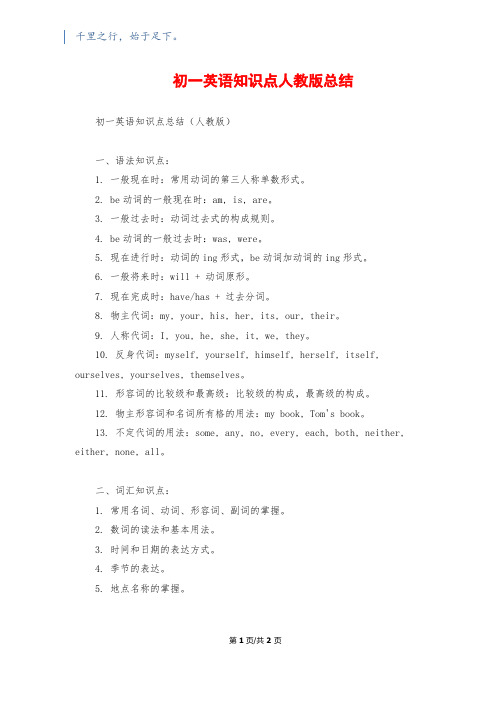
千里之行,始于足下。
初一英语知识点人教版总结初一英语知识点总结(人教版)一、语法知识点:1. 一般现在时:常用动词的第三人称单数形式。
2. be动词的一般现在时:am, is, are。
3. 一般过去时:动词过去式的构成规则。
4. be动词的一般过去时:was, were。
5. 现在进行时:动词的ing形式,be动词加动词的ing形式。
6. 一般将来时:will + 动词原形。
7. 现在完成时:have/has + 过去分词。
8. 物主代词:my, your, his, her, its, our, their。
9. 人称代词:I, you, he, she, it, we, they。
10. 反身代词:myself, yourself, himself, herself, itself, ourselves, yourselves, themselves。
11. 形容词的比较级和最高级:比较级的构成,最高级的构成。
12. 物主形容词和名词所有格的用法:my book, Tom's book。
13. 不定代词的用法:some, any, no, every, each, both, neither, either, none, all。
二、词汇知识点:1. 常用名词、动词、形容词、副词的掌握。
2. 数词的读法和基本用法。
3. 时间和日期的表达方式。
4. 季节的表达。
5. 地点名称的掌握。
第1页/共2页锲而不舍,金石可镂。
三、句型知识点:1. 陈述句的基本句型:主语+谓语+宾语。
2. 疑问句的基本句型:助动词/系动词/情态动词+主语+动词?3. 否定句的基本句型:主语+助动词/be动词/情态动词+not+动词原形。
4. be动词的疑问句和否定句的构成。
5. 以What/Who/Where/When/How开头的特殊疑问句的构成。
四、阅读技巧和写作要点:1. 阅读理解题的解题技巧。
2. 写作要点:选择合适的词汇和句型,注意语法和拼写错误,组织结构和内容的连贯性。
初一英语语法大全知识点
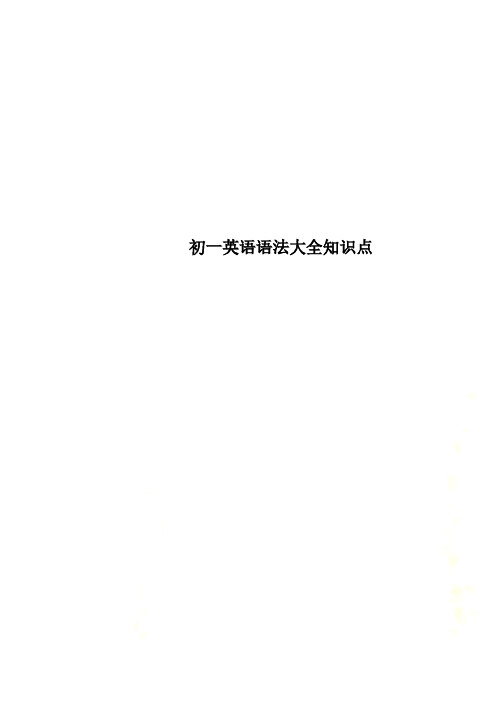
evening ! 例如:
(1) Bob: Good morning , Helen ! Helen : Good morning , Bob !
(2) Bob : Good afternoon , Helen !
Helen : Good afternoon , Bob !
(注
意句子标点)
(3) Bob : Good evening , Helen !
Unit 1 My name’s Gina
一、what is , 缩略式 what’s , 表示“是什么”。
问“某人的名字是什么”、“某人的姓是什么”、
“某人的电话号码是什么”,都用 what is 。
1、问某人的名字句型
问句: What’s your name ?
答句:
My name’s + 名字。
am--------------- I is----------------are --------------
heshe it this tha 单数名词 不可数名词 动词不定式 动名词 we you they these those 复数名词
(第一人称单数主语) (第三人称单数主语)
(复数主语)
about 关于 大
约 us 我们
her 她的
ear 耳朵
English 英语 sure 当然
可以
air 空气
or 或者
any 一些
boy 男孩
orange
橙子,桔子 map 地图
tree 树
math 数学
off 离开
watch 观看
手表 do 做
like 喜欢
beds 床
what 什么
新人教版七年级英语语法知识点汇总

新人教版七年级英语语法知识点汇总七年级英语语法知识点汇总一.字母和音标1.26个英文字母:5个元音字母a, e, i, o, u(联系汉语拼音中的韵母排列顺序快速记忆)2.48个国际音标:20个元音组合,28个辅音组合。
重点辨别相似发音的元音组合。
如:[ə] a Chinabreakfast[e] ea head bread[ei] a name cake二.十大词类名词a.专有名词和普通名词。
专有名词指个别的人,事物,地点等专有的名称,如China, Gina.普通名词如table, chair.b.可数名词和不可数名词:可数名词有复数形式,如an apple,two apples.不可数名词一般没有复数形式,如milk, bread, rice.[重点]可数名词的复数变形:有规则变化和不规则变化两种规则变化:1通俗情况间接在词尾加“-s”,如: bag-bags, day-days, boy-boys, key-keys等。
○2以s, x, sh, ch末端的单词,要在词尾加“-es”,如:bus-buses, watch-watches,○box-boxes等。
3以辅音字母加y结尾的单词,要变y为i再加“-es”,如:baby-babies,○country-countries, family-families等。
4部分以f (e)结尾的单词,要变f (e)为“ves”,如:knife-knives, half-halves等。
○顺口溜:小偷(thief)的妻子(wife),为了自己(self)保命(life),站到架子上(shelf),用树叶(leaf)做的小刀(knife),将狼(wolf)劈成了两半(half)5以字母“o”结尾的单词,没有生命的加“-s”,有生命的加“-es”,如:○zoo-zoos, photo-photos, tomato-tomatoes.口诀:黑人(Negro)英雄(hero)爱在火山(volcano)吃土豆(potato)西红柿(tomato)不规则变化:1改变单数名词中的元音字母:○man-men, woman-women, foot-feet, tooth-teeth等。
人教版初中英语语法完整总结(最新最全)

1 .(see 、hear 、notice 、find 、feel 、listen to 、 look at (感官动词)+(sb.)+do sth.eg:I like watching monkeys jump.2 .(比较级 and 比较级)表示越来越怎么样eg:the more the more 越来越多3. a piece of cake =easy 小菜一碟(容易)4 .agree with sb 赞成某人5 .all kinds of 各种各样 a kind of 一样6 .all over the world = the whole world 整个世界7. along with同……一道,伴随……eg : I will go along with you.我将和你一起去The students planted trees along with their teachers. 学生同老师们一起种树8. as soon as 一怎么样就怎么样9 .as you can see 你是知道的(正如你所见)10 .ask for ……求助向…要…(直接接想要的东西)12. ask sb to do sth 询问某人某事ask sb not to do 叫某人不要做某事13 .at the age of 在……岁时eg:I am sixteen. = I am at the age of sixteen .14.at the beginning of …… ……的起初;……的开始15. at the end of +地点/+时间最后;尽头;末尾eg : At the end of the day16.at this time of year 在每年的这个时候17. be /feel confident of sth /that clause +从句感觉/对什么有信心,自信eg : I am / feel confident of my spoken English.I feel that I can pass the test .18. be + doing 表:1 现在进行时 2 将来时19 .be able to (+ v 原) = can (+ v 原)能够…… eg : She is able to sing .= She can sing. 20. be able to do sth. 能够干什么eg :she is able to sing .21. be afraid to do (of sth 恐惧,害怕…… eg : I'm afraed to go out at night .I'm afraid of dog.22. be allowed to do 被允许做什么eg: I'm allowed to watch TV. 我被允许看电视I should be allowed to watch TV. 我应该被允许看电视23. be angry with sb 生某人的气eg : Don't be angry with me.24. be angry with(at) sb for doing sth为什么而生某人的气25.be as…原级…as 和什么一样eg : She is as tall as me. 她和我一样高26.be ashamed to27.be away from 远离28. be away from 从……离开29. be bad for 对什么有害eg : Reading books in the sun is bad for your eyes. 在太阳下看书对你的眼睛不好30. be born 出生于31.be busy doing sth 忙于做什么事be busy with sth 忙于……32. be careful 当心;小心33.be different from…… 和什么不一样34. be famous for 以……著名35. be friendly to sb 对某人友好36. be from = come from 来自eg :He is from Bejing.He comes from Bejing.Is he from Bejing ? Does he come from Bejing ?37. be full of 装满……的be filled with 充满eg: The glass is full of water.The glass is filled with water.38. be glad+to+do/从句39. be going to + v(原)将来时40. be good at(+doing) = do well in 在某方面善长, 善于……41. be good for 对什么有好处eg : Reading aloud is good for your English.42. be happy to do 很高兴做某事43. be helpful to sb 对某人有好处eg : Reading aloud is helpful to you. 大声朗读对你有好处Exercising is helpful to your body. 锻炼对你的身体有好处44. be in good health 身体健康45. be in trouble 处于困难中eg : She is in trouble. They are in tronble.46. be interested in 对某方面感兴趣47. be late for = come late to 迟到eg: Be late for class 上课迟到48. be like 像…… eg : I'm like my mother.49. be mad at 生某人的气50. be made from 由……制成(制成以后看不见原材料)51. be made of 由……制成(制成以后还看得见原材料)52.be not sure 表不确定53. be on a visit to 参观54. be popular with sb 受某人欢迎55. be quiet 安静56. be short for ···的缩写eg: 陶 is short for 陶俊杰57. be sick in bed 生病在床58.be sorry to do sth be sorry for sbeg : I am sorry for you.59. be sorry to hear that60.be sorry to trouble sbeg : I am sorry to trouble you .61. be strict in doing sth 严于做某事eg : He's strict in obeying rules .62. be strict with sb 对某人要求严格eg: Some students are not strict with themselves. 这些学生对自己不严格63. be strict with sb in sth 某方面对某人严格64. be supposed to do 被要求干什么65. be sure 表确定66.be sure of doing sth 对做某事有信心eg: He is sure of winning. I am sure of learning English well.67. be sure of sth 对做某事有信心eg: I'm sure of my head. (my teacher 我相信我的大脑(老师)68. be sure that sth 对做某事有信心eg: I'm suer that he can pass the test. 我相信他能通过考试69. be sure to do sth一定会做某事eg: We are sure to pass the test. 我们一定会通过这次考试 We are sure to learn English well. 我们一定能学好英语70. be terrified of + 名/动doing 害怕……71.be terrified to do sth 害怕做某事72.be the same as … 和什么一样73. be used to doing sth 习惯做某事eg: My father is used to getting up early. 我爸爸习惯早He is used to sleeping in class. 他习惯上课睡觉74. be worth doing 值-得做什么75. be(feel) afraid to do sth 害怕做某事be afraid of sth 害怕某物be afraid that 丛句76. because+句子 because of +短语eg : He was late because he had a headache. He was late because of his headache .77. begin to do = start to do 开始做某事s tart…with…=begin…with… 以什么开始什么eg : Let's begin the game with the song. I begin to go home78.between…and… 两者之间79. borrow sth from sb 向……借……lend sth to sb ( lend sb sth 借给……什么东西eg : I borrowed a pen from him he lent a pen to me. ( He lent me a pen. )80. both = the same(as) = not different(from) 表相同81. bother 打扰 bother sb to do stheg : I'm sorry to bother you ,but can you tell me to way to the station .我十分道歉打扰你,但是你能告诉我怎么去车站The problem has been bothering me for weeks. 这个问题困扰了我几个周了He's bothering me to lend him money .82. by the end of 到……为止83.call sb sth eg : We call him old wang.84. care 关心eg : Don't you care about this country's future ?你为什么不关心国家的未来85. catch up with sb 赶上某人86.chat with sb 和某人闲谈87. come in 进88. come over to 过来89. come up with 提出eg: Can you come up with a good idea? 你能想出一个好办法吗?90. communicate with sb 和某人交流91. consider + doing 考虑做什么eg : Why not consider going to lu zhou. 为什么不考虑去泸州?92. dance to 随着……跳舞eg : She likes dancing to the music .她喜欢随着音乐跳舞93. decide to do sth 决定做某事94.do a survey of 做某方面的调查95. do better in 在……方面做得更好96. do wrong 做错97.Don't forget to do sth 不要忘了做某事98.Don't mind +doing /从句 /名词不要介意……99. each +名(单)每一个…eg : Each student has many books.每一个学生都有一些书100.end up +doing101. enjoy +doing喜欢102. escape from 从……逃跑eg: The prisoners have escaped from the prison.犯人从监狱里逃跑出来103.expect to do sth 期待做某事104. fall down 摔下来 fall off 从哪摔下来105. fall in love with sb /sth 爱上什么106. far from 离某地远eg : The school is far from my home.107.find +it +adj. +to do 发现做某事怎么样108. find sb/sth +adj. 发现什么怎么样eg : I find the book interesting.109.finish 完成+doing(名词)110. fit to sb = be fit for sb 适合某人111.forget to do 没有做而忘了 forget doing 做了而又忘了eg: Don't forget to go home, I forget closing door .112.from…to… 从某某到某某eg: From me to her113. get /have sth down 做完,被(别人)做…eg: I have my hair cut. 我理了发(头发被剪了)Tom got his bad tooth pulled out. 汤母把他的坏牙拔掉了(被牙医拔掉了)114. get a part-time job= find a part-time job 115. get along well with sb = get on well with sb 与某人相处得好116. get along with sb = get on with sb 与某人相处117.get ready for = be ready for为什么而准备eg : I get ready for math exam.I am ready for math exam.118.get sb in to trouble给某人制造麻烦,使某人陷入麻烦119.get sb to do sth120.get…from… 从某处得到某物121. give a talk 做报告 eg: He is give a talk. 122. give sth. to sb.= give sb. sth.给某人某物123. go fish 钓鱼 go swimming 游泳124. go on to do 去做下一件事 go on doing 继续做这件事125. go out away from =go out of126. go to school 上学(用于专业的)go to the school 去学校(不一定是上学)127. good way to 好方法128. hate to do 讨厌没做过的事hate doing 讨厌做过的事129. have a party for sb 举办谁的晚会130.have a talk 听报告谈一谈131. have been doing 现在完成进行时eg : You have been talking You have been sleeping since.132.have been to …( 地方)……去过某过地方have gone to …(地方)去了某地还没回来133. have fun +doing 玩得高兴134.have sth to do 有什么事要做eg: I have a lot of homework to do. 我有很多家庭作业要做I have nothing to do. 我没什么事情做135. have to do sth 必须做某事136. have trouble (problem) (in) doing sth 做什么事情有麻烦137.have…time +doing138.have…(时间)…off 放……假eg: I have month off 我请一个月得假139. hear sb +do/doing 听见某人做某事/正在做某事140. help a lot 很大用处141. help sb with sth \one's sth 帮助某人某事(某方面) help sb (to) do sth 帮助某人做某事142. hope to do sth 希望做某事143. How about(+doing) = What about(+doing) 144. how do you like = what do you think of 你对什么的看法145. if : 是否=wethereg: I don't know if (wether) I should go to the party .我不知道我是否应该去参加晚会He don't know if (wether) we will arrive on time tomorrow morning .他不知道我们明天早上是否能准时到达146.if :如果,假如(全部接一般时态)+条件语态从句eg: I'll go to LuZhou if it does't rain. 假如明天不下雨,我就去泸州If they change the plan they will let me know. 假如他们要改变计划,他们会让我知道的I'll go to England ,if I have enough money next year .如果我明年由足够的钱,我就要去英国147. in one's opinion = sb think 某人认为148. in some ways 在某些方面149.in the end = finally(adv) 最后150.in the north of… 什么在什么的北方( north 北 sowth 南 west 西 east 东)151. in the sun 在太阳下152. increase 增加eg : They've increased the piece of petrol by 3% .他们把石油价增加了3%The population has increased from 12 million ten years ago to 18 million now .153. instead of +(名)代替eg: I'd like an apple instead of a pear. 我想要苹果,而不要梨子I like English instead of math. 我喜欢英语而不喜欢数学154. introduce sb to sb 介绍某人给某人introduce oneself 自我介绍155. invite sb to do sth 邀请某人做某事156. It takes sb sometime to do sth 做某人花掉某人多少时间eg : It took me 5 minutes to do my homework . It takes me half an hour to cook.157. It's +adj +for sb to do sth 对某人来说做某事怎么样158. It's +adj +to do 做某事怎么样159. It's +adj for sb 对于某人来说怎么样It's +adj of sb 对某人来说太怎么样160. It's +adj(for sb) to do(对某人来说)做某事怎么样It's +adj of sb to do sth 对某人来说做某事太怎么样eg : It's nice of you to help me with my English. 161. It's a good idea for sb to do sth 对…… 来说是个好主意162. It's important to sb 对某人来说很重要eg: It's important to me.163. It's time to do sth = It's time for sth 到了该去做某事的时间eg : It's time to have class It's time for class. 该去上课了164. join = take part in 参加165. just now 刚才166. keep +sb /sth +adj /介词短语让什么保持什么样?167. keep out 不让…… 进入168. keep sb adj 让……保持……eg: I want to keep my mother happy/ keep healthy.保持高兴/健康169. key to +名词表示:某物的钥匙或某题的答案170.key to… key 可以是答题或钥匙anser to …ugh at… 取笑……eg : Don't langh at others.We langhed at the joke.172. learn by oneslfe 自学173. learn from sb 向某人学习eg: We should learn from Lei Feng.174. learn to do sth 学做某事175. let sb do sth 让某人做某事176. Let sb down 让某人失望eg : We shouldn't let our farents down. 我们不应该让我们的父母失望177. live from :离某地远178. live in +大地方 /at +小地方居住在某地eg: I live in LuZhou.She lives at XuanTan . 179. look after = take care of 照顾照看180.lose one's way 谁迷路eg : Lose your way. 你迷路了181. make a decision to do sth 决定做某事182. make friends with sb 和谁成为朋友eg : I want to make friends with you.183. make it early 把时间定的早一点184. make on exhibition of oneself 让某人出洋相185. make sb /n +n 使什么成为什么eg : I made you my wife.186. make sb /sth +adj 使某人(某物)怎么样eg : You must made your bed clean.187. make sb /sth adj 使某人/某物怎么样188. make sb do sth 让某人做某事eg : I made him write. 我以前让他写189. make up be made up of (被动语态)由……组成190.make…difference to…191. mind sb to do mind one's doing 介意……做什么192. most +名 most of +代193. much too +形容词194.must be 一定195. need +名词196. need sb do sth 需要某人做某事197.need to do (实义动词) need do (情态动词)198. no /neithr of hate to do no /neithr of hate doing199. no +名词200. not anymore = no more 再也不……eg: He didn't cry any more He cried no more. 他再也不哭201.not… (形、副)at all eg: He's not tall at all she doesn't junp far at all .202.not…at all 一点都不203.not…either 表否定,也不eg : I don't have sister, either. 我也没有姐姐204.not…until 直到……才……eg: I didn't sleep until my mother came back. The child didn't stop crying until I give her sugar.205. offer / provide sb with sth 给某人提供206. offer sb sth ( offer sth to sb 提供什么东西给某人eg : I offer you water .(I offer water to you .)我给你提供水207.on one's way to… 在谁去那的路上208. on the one hand 一方面on the other hand 另一方面209. on the phone = over the phone 用电话交谈210. on time 准时 in time 及时211. one day =some day =someday 一天,有一天212. one of +可数名词的复数形式213. one to another 一个到另一个214. over and over agin 一遍又一遍的eg : He cleaned the floor over and over agin . 215. part-time job 兼职工作 fall-time job 全职工作216.pay for… 付……钱 pay the bill 开钱,付钱217. please +do218. please help yourself219. pleased with sb220. pool into = pore into221. practice +doing 练习做某事222. prefer sth to sth 相对……更喜欢……eg : I prefer physics to chemisty.在物理和化学中,我更喜欢物理prefer doing to sth 更喜欢去做…不愿意去做… eg: He prefers riding a bike to diving.他更喜欢骑自行车,不开小车prefer to do sth rather than do sth 宁愿做…也不愿eg: My unde prefers to buy a now car rather than repaiv the used one. 我叔叔更喜欢买新的车,也不去修旧车prefer sb not to do sth 更愿意…eg: I prefer her not to come 我不喜欢她不来223. pretend to do sth 装着去做什么pretend that 从句eg : The two cheats pretended to be working very hard .这两个骗子装着努力工作He pretended that he did not know the answer .他装着不知道答案224 .rather…than 宁可……也不……eg : I would rather be a doctor than a teacher. 我愿肯当医生,也不当老师He likes dogs rather than cats. 他喜欢狗,不喜欢猫225.regard…as 把……当作…… eg: Please give my best regards to your family. 请带我向你的家人我最好的问候I regard you as my friend. 我把你当作我的朋友He shows little regard for others.他不爱关心别人226. remid sb about sth 提醒某人什么事remid sb to do sth 提醒某人做某事eg : he remids me about cooking (He remids me to cook. 他提醒我做饭227. remid sb of sth 使某人想起什么eg : The pictures remind me of my school days. 这照片使我想起了我的学校T he wor ds that (which) the teacher talke to remind me of my mother.228. return sth to sb 还什么东西给某人229. say to oneself 对自己说230. say to sb 对某人说231. sb spend somemoney on sth 花了多少钱在某事上232. sb spend sometime with sb 花了多少时间陪谁233. sb spend sometime(in) doing sth 花了多少时间做某事234. sb with sb +is sb and sb +are235. see sb do 看见某人做过某事see sb doing 看见某人正在做某事236. seem to do/be +adj 显得怎么样eg : You seem to be tired .You seem to be happy. 237. send +sb sth 送给某人某物238.send…to…把什么寄到哪里去?239. shock 使……震惊eg : Oh , It's only you ! You give me a shock .啊,是你呀!吓我一跳240. show sb sth 向某人展示某物eg : I show her the book.241. show sb sth = show sth to sb 拿什么东西给某人看eg: Show me your pen.= Show your pen to me. 242. show sth to sb 向某人展示某物eg : I show the book to her.243. some…others… 一些……另一些…… 244.start…with… 从……开始begin…with… 从……开始。
(完整版)新人教版七年级英语语法知识点汇总
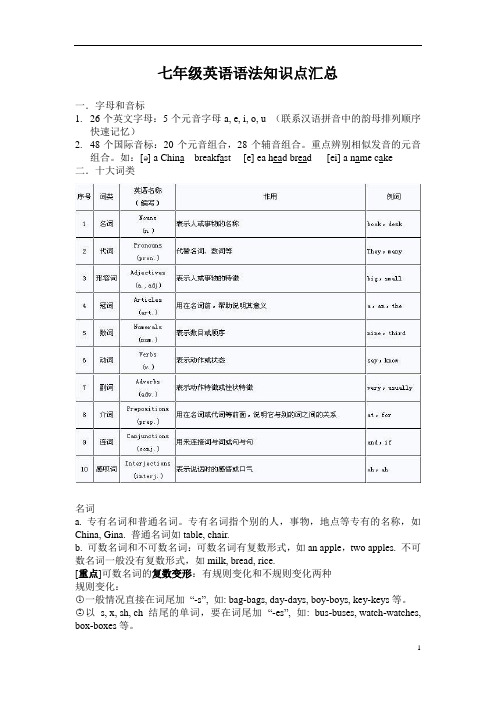
七年级英语语法知识点汇总一.字母和音标1.26个英文字母:5个元音字母a, e, i, o, u (联系汉语拼音中的韵母排列顺序快速记忆)2.48个国际音标:20个元音组合,28个辅音组合。
重点辨别相似发音的元音组合。
如:[ə] a China breakfast [e] ea head bread [ei] a name cake 二.十大词类名词a. 专有名词和普通名词。
专有名词指个别的人,事物,地点等专有的名称,如China, Gina. 普通名词如table, chair.b. 可数名词和不可数名词:可数名词有复数形式,如an apple,two apples. 不可数名词一般没有复数形式,如milk, bread, rice.[重点]可数名词的复数变形:有规则变化和不规则变化两种规则变化:○1一般情况直接在词尾加“-s”, 如: bag-bags, day-days, boy-boys, key-keys等。
○2以s, x, sh, ch结尾的单词,要在词尾加“-es”, 如: bus-buses, watch-watches, box-boxes等。
○3以辅音字母加y结尾的单词,要变y为i再加“-es”, 如:baby-babies, country-countries, family-families等。
○4部分以f (e)结尾的单词,要变f (e)为“ves”, 如:knife-knives, half-halves等。
顺口溜:小偷(thief)的妻子(wife),为了自己(self)保命(life),站到架子上(shelf),用树叶(leaf)做的小刀(knife),将狼(wolf)劈成了两半(half)○5以字母“o”结尾的单词,没有生命的加“-s”,有生命的加“-es”,如:zoo-zoos, photo-photos, tomato-tomatoes.口诀:黑人(Negro)英雄(hero)爱在火山(volcano)吃土豆(potato)西红柿(tomato)不规则变化:○1改变单数名词中的元音字母:man-men, woman-women, foot-feet, tooth-teeth等。
七年级上册英语语法整理(人教版)
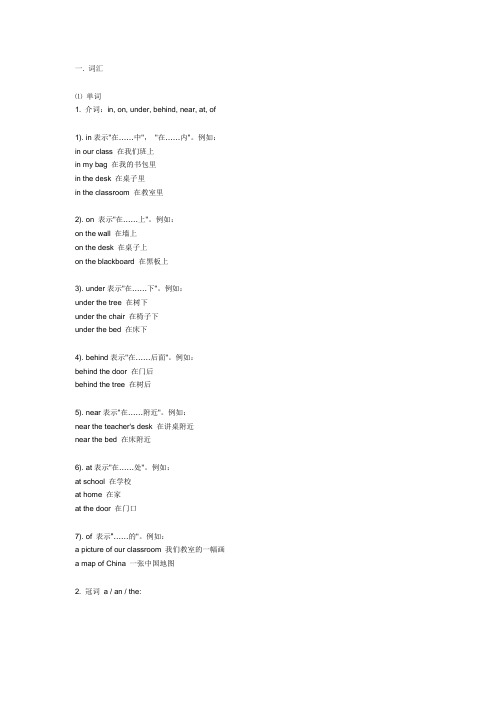
一. 词汇⑴单词1. 介词:in, on, under, behind, near, at, of1). in表示"在……中","在……内"。
例如:in our class 在我们班上in my bag 在我的书包里in the desk 在桌子里in the classroom 在教室里2). on 表示"在……上"。
例如:on the wall 在墙上on the desk 在桌子上on the blackboard 在黑板上3). under表示"在……下"。
例如:under the tree 在树下under the chair 在椅子下under the bed 在床下4). behind表示"在……后面"。
例如:behind the door 在门后behind the tree 在树后5). near表示"在……附近"。
例如:near the teacher's desk 在讲桌附近near the bed 在床附近6). at表示"在……处"。
例如:at school 在学校at home 在家at the door 在门口7). of 表示"……的"。
例如:a picture of our classroom 我们教室的一幅画a map of China 一张中国地图2. 冠词a / an / the:冠词一般位于所限定的名词前,用来署名名词所指的人或事物。
冠词有不定冠词和定冠词两种。
不定冠词有两个形式,即a和an。
a用在以辅音音素开头的词前,如a book; an用在以元音音素开头的字母前,如an apple.a或an与可数名词单数连用,泛指某类人或某物中的一个。
This is a cat.这是一只猫。
It's an English book.这是一本英语书。
2024人教版七年级英语
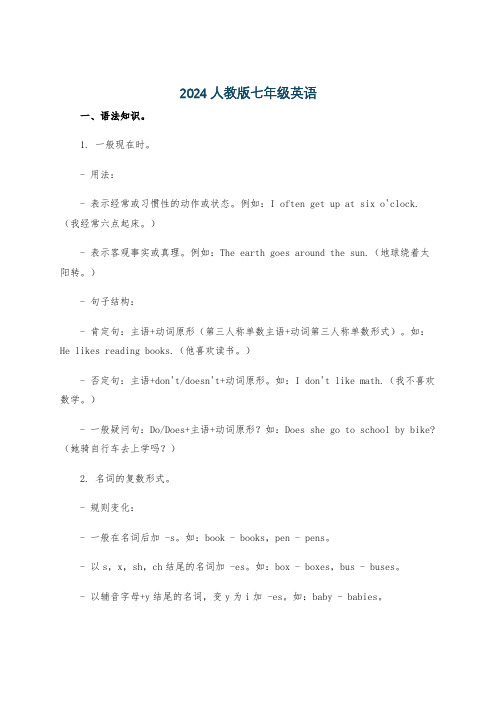
2024人教版七年级英语一、语法知识。
1. 一般现在时。
- 用法:- 表示经常或习惯性的动作或状态。
例如:I often get up at six o'clock.(我经常六点起床。
)- 表示客观事实或真理。
例如:The earth goes around the sun.(地球绕着太阳转。
)- 句子结构:- 肯定句:主语+动词原形(第三人称单数主语+动词第三人称单数形式)。
如:He likes reading books.(他喜欢读书。
)- 否定句:主语+don't/doesn't+动词原形。
如:I don't like math.(我不喜欢数学。
)- 一般疑问句:Do/Does+主语+动词原形?如:Does she go to school by bike?(她骑自行车去上学吗?)2. 名词的复数形式。
- 规则变化:- 一般在名词后加 -s。
如:book - books,pen - pens。
- 以s,x,sh,ch结尾的名词加 -es。
如:box - boxes,bus - buses。
- 以辅音字母+y结尾的名词,变y为i加 -es。
如:baby - babies。
- 以o结尾的名词,有生命的加 -es(如:potato - potatoes,tomato - tomatoes),无生命的加 -s(如:photo - photos)。
- 不规则变化:- 例如:man - men,woman - women,child - children,foot - feet,tooth - teeth等。
3. 形容词性物主代词。
- 包括:my(我的),your(你的/你们的),his(他的),her(她的),its (它的),our(我们的),their(他们的)。
- 用法:用来修饰名词,表示所属关系。
例如:This is my book.(这是我的书。
)二、词汇积累。
(完整版)最全的人教版七年级英语语法总结
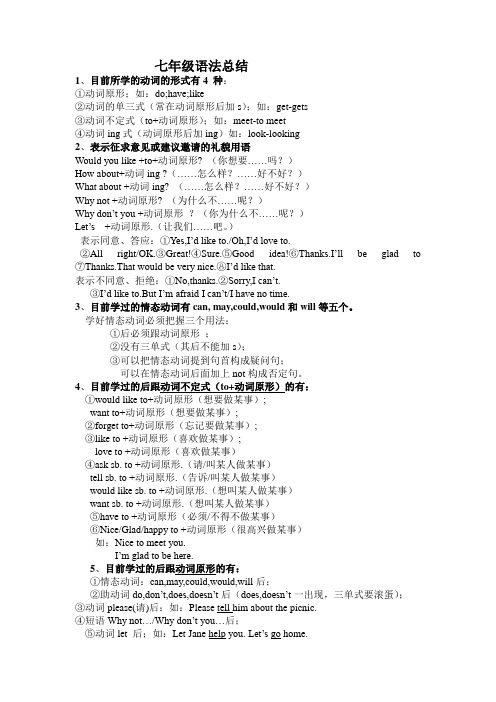
yuan---yuan(人民币元)
4) mouse—mice (老鼠) child—children(儿童)
5)合成词中一般变后面的词:apple tree---apple trees(苹果树)
但下列需前后都变:man teacher---men teachers(男教师)
woman doctor---women doctors(女医生)
7、有单复数变化的词
①名词
(1) 名词单数变复数的方法
1)大部分在词尾加 s.如:dog---dogs
2)以-s, -x, -ch, -sh 结尾的加 es. 如:
class---classes bus---buses glass---glasses
box---boxes watch---watches(手表)
How about +动词 ing? —How about g.o..in.g.fishing this Sunday?
It’s time for g.o..in.g.home=It’s time to go home.
Thank you for h.e..lp..in.g.me=Thank you for your help.. ③go +动词 ing——go fishing 去钓鱼; go shopping 去购物 ④do some shopping 购物 ⑤like/love +动词 ing (喜欢做某事)
⑥动词 help 后,也可带 to;如:Let’s help Maria (to) carry water. ⑦祈使句以动词原形开头,如:Have a seat , please.请坐下。 6、目前学过的后跟动词 ing 的有: ①Be 动词后的动词;如:Are you k..id.d..in.g.? I’m just .lo.o.k..in.g..
人教版七年级英语语法归纳
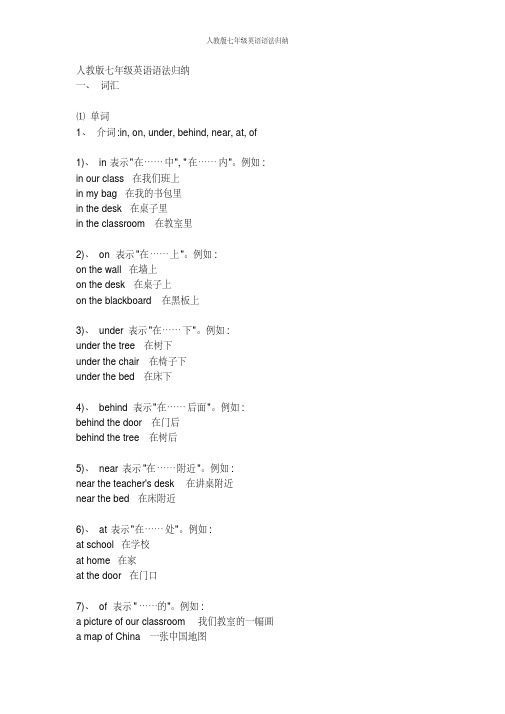
人教版七年级英语语法归纳一、词汇⑴单词1、介词:in, on, under, behind, near, at, of1)、in表示"在……中", "在……内"。
例如: in our class 在我们班上in my bag 在我的书包里in the desk 在桌子里in the classroom 在教室里2)、on 表示"在……上"。
例如:on the wall 在墙上on the desk 在桌子上on the blackboard 在黑板上3)、under表示"在……下"。
例如:under the tree 在树下under the chair 在椅子下under the bed 在床下4)、behind表示"在……后面"。
例如: behind the door 在门后behind the tree 在树后5)、near表示"在……附近"。
例如:near the teacher's desk 在讲桌附近near the bed 在床附近6)、at表示"在……处"。
例如:at school 在学校at home 在家at the door 在门口7)、of 表示"……的"。
例如:a picture of our classroom 我们教室的一幅画a map of China 一张中国地图2、冠词 a / an / the:冠词一般位于所限定的名词前,用来署名名词所指的人或事物。
冠词有不定冠词与定冠词两种。
不定冠词有两个形式,即a与an。
a用在以辅音音素开头的词前,如a book; an用在以元音音素开头的字母前,如an apple、a或an与可数名词单数连用,泛指某类人或某物中的一个。
This is a cat、这就是一只猫。
人教版七年级英语语法点

人教版七年级英语语法点一、名词。
1. 可数名词与不可数名词。
- 可数名词有单复数形式。
复数形式的构成规则如下:- 一般情况加 -s,如book - books,pen - pens。
- 以s,x,ch,sh结尾的加 -es,如bus - buses,box - boxes,watch - watches,brush - brushes。
- 以辅音字母+y结尾的,变y为i再加 -es,如baby - babies。
- 以o结尾的,有生命的加 -es(如tomato - tomatoes,potato - potatoes),无生命的加 -s(如photo - photos,piano - pianos)。
- 以f或fe结尾的,变f或fe为v再加 -es,如knife - knives,leaf - leaves。
- 不可数名词没有复数形式,如water,milk,bread等。
表示数量时,要用“数词+量词+of+不可数名词”,如a glass of water,two cups of tea。
2. 名词所有格。
- 有生命的名词所有格:- 一般在名词后加's,如Tom's book。
- 以s结尾的复数名词,只加',如the students' classroom。
- 表示两者或多者共有时,只在最后一个名词后加's;表示各自拥有时,每个名词后都要加's。
例如:Tom and Jerry's room(他们共有的房间);Tom's and Jerry's rooms(他们各自的房间)。
- 无生命的名词所有格常用“of+名词”结构,如the window of the room。
二、代词。
1. 人称代词。
- 主格:I,you,he,she,it,we,you,they,在句中作主语。
例如:I am a student. He likes reading.- 宾格:me,you,him,her,it,us,you,them,在句中作宾语。
七年级英语语法知识点人教

七年级英语语法知识点人教Part 1 词汇基础1. 名词:代表人、事物、地点、抽象概念等。
2. 代词:代替特定的人、事物、抽象概念等。
3. 形容词:修饰名词或代词,表示特征、性质等。
4. 副词:修饰动词、形容词、其他副词等,表示时间、方式、程度、原因等。
5. 动词:表示行为或状态的词。
6. 介词:连接名词或代词与其他词汇,表示空间、时间、关系等。
7. 连词:连接词语、短语、句子等,让它们在语法上产生关联。
8. 冠词:用于限定名词。
Part 2 句型1. 简单句:只包含一个主语和一个谓语的句子。
2. 复合句:包含一个主句和一个或多个从句的句子。
3. 并列句:两个或更多简单句并列而成,用连词连接。
4. 疑问句:用于提问,以动词第一次出现作为句子的开头。
5. 肯定句和否定句:肯定句表示一个肯定的事实,否定句表示某事不是真的。
Part 3 时态1. 一般现在时:表示通常或经常发生的事件。
2. 现在进行时:表示现在正在进行的事件。
3. 一般过去时:表示过去发生的事情。
4. 过去进行时:表示过去某个时间正在进行的事件。
5. 将来时:表示将要发生的事件。
Part 4 语态1. 主动语态:表示主语是动作的执行者。
2. 被动语态:表示主语是动作的承受者,动作的执行者不一定提及。
Part 5 常见句型1. There be句型:表示某处有某事或某人。
2. have/has+过去分词:表示已经发生的动作对现在有影响。
3. be going to:表示未来打算或计划做某事。
4. should/shouldn't:表示应该或不应该做某事。
5. can/can't:表示能够或不能够做某事。
6. must/mustn't:表示必须或禁止做某事。
Part 6 语法注意事项1. 名词复数形式的构成规则。
2. 形容词的比较级和最高级形式。
3. 副词和形容词的用法区别。
4. 代词和名词的不同用法。
5. 定冠词和不定冠词在句中的用法。
初一英语语法大全知识点

初一英语语法大全知识点人教版七年级(上册)英语知识点第一块国际音标国际音标是一种工具,其作用是标记英语字母和单词的读音。
1、20个元音单元音:/i:/Ee、/з:/her /u:/do/I/it /ә/about /u/book/ɑ:/are //or /æ/any//us //off /e/at双元音://Ii //out //ear//Aa,//Oo //air//boy //sure2、28辅音:成对的清浊辅音:/p/map /t/it /k/book /f/off /θ/math /s/yes/b/club /d/dad /g/big /v/have /ð/this /z/zoo//fish //watch /tr /tree /ts/its//usually //orange /dr/dress /dz/beds其他辅音:/m/am /n/and //English /l/like/h/hello /r/red /w/what /j/yes3、国际音标拼读规则:辅见元,碰一碰。
/l/在前,发本音;音节后面卷下舌。
/p/、/t/、/k/、/tr /清辅音,/s/后读成浊辅音。
本块词汇:speak说讲start开始school学校 s trict严格的out外面club俱乐部usually通常 dress化妆about关于大约us我们= I’m well 一定要向对方说谢谢。
以用简略语言:And you ?Bob : I’m fine , too . 我也很好。
2、2、问一个东西“英语名字”的常用句型Helen : What’s this / that in English ? 这个用英语怎么说?↘(答句中,一定用it 代替this / that)Bob : It’s a / an + 英语名称。
( key jachet quilt orange ruler pen )Helen : Spell it , please . ( = How do you spell it ? ) 请拼写它。
人教版初一英语语法大全

人教版 -- 初一英语语法大全〔 1〕1.形容词的用法形容词用以修饰名词,表示人或事物的特征。
在句中可以作定语、表语,用于限定被修饰语的特征,如长短、大小、重量、颜色、高矮、胖瘦、新旧等,。
The little girl is very pretty.这个小女孩很好看。
--I want that one.我想要那个。
--Which one? 哪一个 ?--The new blue one.那个蓝色新的。
Can I have a look at the big nice one?我能看一看那个大的漂亮的吗 ?2、人称代词是用来表示人的代词,有单数和负数之分,有主格和宾格之分。
人称代词的主格在句中作主语 ; 人称代词的宾格在句中作宾语,是作动词或介词的宾语。
主格: I, we, you, he, she, it, they在句子中作主语宾格: me, us, you, him, her, it, them在句子中作宾语He and I are in the same class.我和他在同一个班级。
Can you see them in the street?你能看见他们在街上吗 ?3、可数名词和不可数名词英语中名词分为可数名词和不可数名词。
但凡可数计数的名词叫做可数名词以计数的名词叫做不可数名词。
; 但凡不可(1)可数名词分为单数和复数两种形式。
可数名词前可以用不定冠词、数词或 some many 等修饰。
如: a man a desk an apple an orange some books some children tow pens(2)不可数名词没有复数形式,前面不能用不定冠词、数词或 many等词语修饰,但可以用some a little much等词语来修饰。
有时可以与一些量词短语搭配,这些量词短语中的名词一般是可数的,有单数形式,也可以有复数形式。
如:some water a little milk much food a piece of bread tow bottles of ink some glasses of water4、祈使句祈使句用来表示请求、命令等,句中没有主语,肯定形式由谓语或者谓语补足语 ) 构成,否认形式那么在句前加Don’ t.Stand up, please.请起立。
人教版初一英语语法汇总
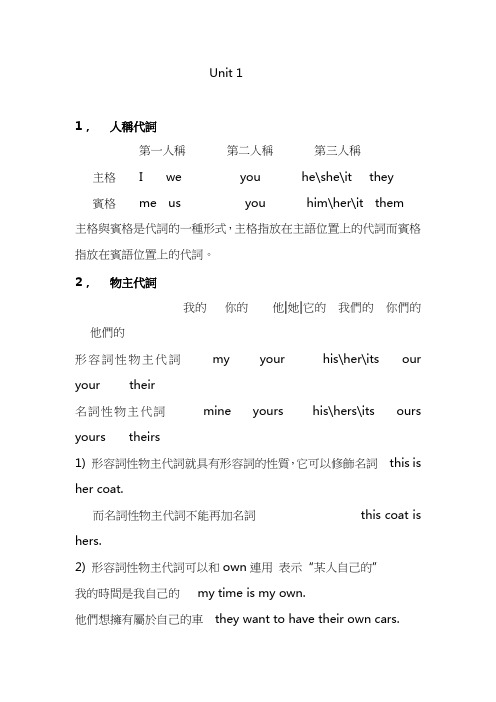
Unit 11,人稱代詞第一人稱第二人稱第三人稱主格I we you he\she\it they賓格me us you him\her\it them主格與賓格是代詞的一種形式,主格指放在主語位置上的代詞而賓格指放在賓語位置上的代詞。
2,物主代詞我的你的他|她|它的我們的你們的他們的形容詞性物主代詞my your his\her\its our your their名詞性物主代詞mine yours his\hers\its ours yours theirs1) 形容詞性物主代詞就具有形容詞的性質,它可以修飾名詞this is her coat.而名詞性物主代詞不能再加名詞this coat is hers.2) 形容詞性物主代詞可以和own連用表示“某人自己的”我的時間是我自己的my time is my own.他們想擁有屬於自己的車they want to have their own cars.3,指示代詞this和these用來指時間或空間上較近的事物that 和those用來指時間和空間上較遠的事物4,名詞1)名詞一般可以分為專有名詞和普通名詞,專有名詞指的是個別的人,物,事,其第一個字母要大寫,如Jim China World war2)普通名詞分為可數和不可數名詞3)少數名詞的複數形式是不規則的,要積累並記憶。
如women knives sheep5, 名詞的所有格1)如果名詞是單數,最後一個字母不是S, 直接加“’s” her sister’s book2)如果名詞是單數,且最後一個字母是S,可加“’”,也可加“’s”James’book \ James’s book3)如果名詞已經是複數,而且最後一個字母是S,則加“’”即可workers’ room4)如果名詞已經是複數,但是最後一個字母不是S,則加“’s” children’s book s6,“主語+be+表語” 這叫做主系表結構I am Jim. …was…My name is Jim. …were…Her name is Jim. …are…His name is Jim.7, 把系動詞BE的各種形式提到句首,就變成了一般疑問句Is this yours?Are you ok?Was xiaoming a student?Were there five students?8, clock 鐘watch 表9, 注意構詞法“形容詞變副詞一般加ly”nice (adj)-----nicely(adv)10,meet(v)見面、遇見、相逢we can meet at the school gate. 我們可以在校門口見面。
- 1、下载文档前请自行甄别文档内容的完整性,平台不提供额外的编辑、内容补充、找答案等附加服务。
- 2、"仅部分预览"的文档,不可在线预览部分如存在完整性等问题,可反馈申请退款(可完整预览的文档不适用该条件!)。
- 3、如文档侵犯您的权益,请联系客服反馈,我们会尽快为您处理(人工客服工作时间:9:00-18:30)。
人教版--初一英语语法大全(1)1. 形容词的用法形容词用以修饰名词,表示人或事物的特征。
在句中可以作定语、表语,用于限定被修饰语的特征,如长短、大小、重量、颜色、高矮、胖瘦、新旧等,。
The little girl is very pretty. 这个小女孩很好看。
--I want that one. 我想要那个。
--Which one? 哪一个?--The new blue one. 那个蓝色新的。
Can I have a look at the big nice one? 我能看一看那个大的漂亮的吗?2、人称代词是用来表示人的代词,有单数和负数之分,有主格和宾格之分。
人称代词的主格在句中作主语;人称代词的宾格在句中作宾语,是作动词或介词的宾语。
主格:I, we, you, he, she, it, they在句子中作主语宾格:me, us, you, him, her, it, them在句子中作宾语He and I are in the same class. 我和他在同一个班级。
Can you see them in the street? 你能看见他们在街上吗?3、可数名词和不可数名词英语中名词分为可数名词和不可数名词。
凡是可数计数的名词叫做可数名词;凡是不可以计数的名词叫做不可数名词。
(1)可数名词分为单数和复数两种形式。
可数名词前可以用不定冠词、数词或some many 等修饰。
如:a man a desk an apple an orange some books some children tow pens(2)不可数名词没有复数形式,前面不能用不定冠词、数词或many等词语修饰,但可以用some a little much等词语来修饰。
有时可以与一些量词短语搭配,这些量词短语中的名词一般是可数的,有单数形式,也可以有复数形式。
如:some water a little milk much food a piece of bread tow bottles of ink some glasses of water4、祈使句祈使句用来表示请求、命令等,句中没有主语,肯定形式由谓语或者谓语+宾语(+宾语补足语)构成,否定形式则在句前加Don’t.Stand up, please. 请起立。
Don’t worry. 别担心。
can的用法:can是情态动词,表示“能,会,可以,被允许等”,其后接动词原形,否定形式为cannot,可缩写为can’t.She can speak Japanese. 她会讲日语。
I can’t remember his name. 我不记得他的名字了。
Can you spell your name? 你会拼写你的名字吗?5、现在进行时态概念:表示现在(说话瞬间)正在进行或发生的动作,也可以表示目前一段时间内或现阶段正在进行的活动。
结构:由be动词(am, is, are) + 动词ing构成,其中be动词要与主语保持性数一致。
Mary is flying a kite in the park. 玛丽正在公园里放风筝。
--What are you doing now?你现在在干什么?--I’m reading English. 我正在读英语。
Are they drawing the pictures now?他们正在画画吗?动词现在分词是动词原形变化而来的,规则变化如下:动词ing形式叫动词现在分词,其构成如下:1) 直接在动词后加ingplay—playing, do—doing, talk—talking, sing--singing2) 以不发音的字母e结尾的动词,先去e,再加ingmake—making, write—writing, have—having, take—taking3) 以重读闭音节结尾的动词且词尾只有一个辅音字母,应双写这个辅音字母,再加ingrun—running, stop—stopping, put—putting, swim—swimming注意对现在进行时态的判断。
判断一个英语句子用什么时态,主要看句子的时间状语,一般说来,每种时态都有与之相对应的时间状语。
现在进行时表示现在(说话瞬间)正在进行或发生的动作。
因此,这个时态最常用的时间状语是now;但有不少句子并没有now,只能通过提示语如look、listen等或者通过上下文来确定用现在进行时。
She is cleaning her room now. 她正在打扫房间。
Look! The girl is dancing over there. 看!那个女孩在那里跳舞。
--Can you go and play games with me? 你能和我们一起做游戏吗?--Can’t you see I am doing my homework? 你没看见我正在做作业吗?6、have/ has的用法1) 谓语动词have表示“有”,有两种形式:have和has,前者用于第一人称(I, we),第二人称(you)和第三人称复数(they),后者用于第三人称单数(he, she, it)或单数名词。
I have an apple and he has two bananas. 我有一个苹果,他有两个香蕉。
You have a new English teacher. 你们有了一个新的英语老师。
It has two big eyes. 它有一双大眼睛。
Julie and Jack have a nice car. 朱莉和杰克有一辆好看的车。
2) have/has句型与there be句型的比较:两者都表示“有”,但用法不同。
前者表示所属关系,即表示“某人或某物有什么”,而后者表示存在,表示“某地有什么”。
They have some new books. 他们有一些新书。
There are some new books on their desks. 他们桌子上有一些新书。
She has a lot of pretty skirts. 她有很多漂亮的裙子。
There are a lot of pretty skirts in the shop. 商店里有很多漂亮的裙子。
3) have/ has的否定句,一般要加助动词do/ does,再加not构成,即do not have (don’t have)/ does not have (doesn’t have). She does not have a sister. 她没有姐姐。
We don’t have any classes on Saturday. 我们星期六没有课。
Ann and I don’t have a big room. 我和安没有一个大房间。
4) 一般疑问句由“助动词Do/ Does + 主语+ have + 宾语”构成,回答用Yes, …do/ does.或者No, …don’t/ doesn’t.--Do you have a big house? 他们的房子大吗?--No, they don’t. 不,他们的房子不大。
--Does he have an eraser? 他有橡皮吗?--Yes, he does. 他有的。
5) 特殊疑问句由特殊疑问词+ 助动词do/ does + have (+状语)构成。
What do they have? 他们有什么?What does he have? 他有什么?How many telephones do they have? 他们有几部电话?7、介词用法1) 具体时间前介词用at。
. He gets up at half past seven every day. 他每天七点半起床。
She goes to bed at eleven o’clock. 她十一点睡觉。
2) 表示“在早上,在下午,在晚上”的短语中用介词in,且定冠词the不能省略;表示“在中午,在夜里”的短语中介词用at,不加冠词。
in the morning在早上,in the afternoon 在下午,in the evening 在晚上at noon在中午,at night在夜里3) 表示“在某天”、“在某天的上午、下午等”的短语用介词on。
What do you usually do on Monday morning? 星期一上午你通常做什么?Do you sometimes go out to eat on Friday evening? 有时你星期五晚上出去吃饭吗?He watches DVDs on Saturday night. 星期六晚上他看DVD。
Parents take children to parks on June 1. 六月一日,家长们带着孩子去公园。
4) 在this, last, next, every等词前面既不加介词,也不用冠词。
What are you doing this afternoon? 今天下午你做什么?He visits his grandma every Friday. 他每个星期五都去看望祖母。
She is going to Shanghai next Monday. 她下个星期一去上海。
8、一般现在时一般现在时表示经常性或习惯性的动作,或表示现在的特征或状态。
其动词形式是:动词原形(只有第三人称单数作主语时除外,要加-s)其疑问句和否定句需要用助动词do或does1) 肯定句用行为动词原形表示They get up very early every morning. 他们每天早晨起来很早。
I visit my grandparents four times a month. 我一个月去看望祖父母四次。
2) 否定句用don’t + 动词原形来表示We do not go shopping on Sundays. 我们周日不去购物。
I don’t think you like this colour. 我想你不喜欢这个颜色。
3) 一般疑问句则是把助动词do提前至句首,后面动词用原形。
回答时,肯定用“Yes, 主语+do”;否定句用“No, 主语+don’t”。
–Do they go to school at seven o’clock? 他们七点去上学吗?--Yes, they do.--Do you like this skirt? 你喜欢这条裙子吗?--No, I don’t. 不,我不喜欢。
一般现在时用来表示经常的或习惯性的动作,常与以下的时间状语连用:often 经常,always 总是,sometimes 有时,usually 通常,every day/ week 每天/ 周等。
